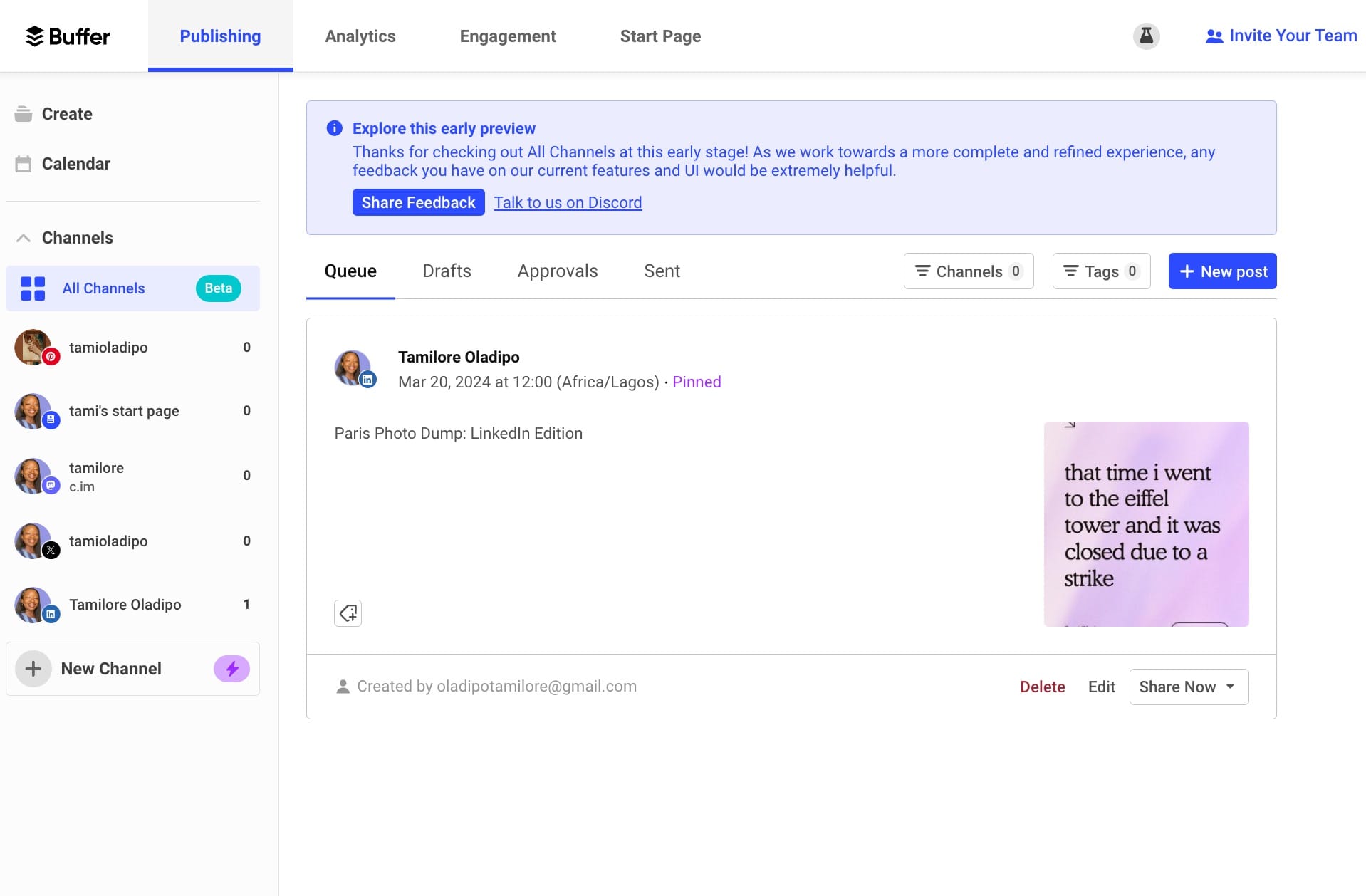
Ask Buffer: Should I Schedule Natively or Use Buffer?
We examine why you might pick a tool like Buffer over just using the scheduling features in the apps themselves.

Content Writer @ Buffer
Question: I'd like for you to tell me what the value of using a social media tool like Buffer is compared to Meta Business Suite specifically.
Great question!
The big five, also known as Meta’s Instagram and Facebook, then LinkedIn, TikTok, and X/Twitter, have all integrated some form of scheduling since they came to be.
Meta launched Meta Business Suite (then known as Facebook Business Suite) in 2020, while LinkedIn launched in 2022, and TikTok and Twitter (for Premium users) allow desktop scheduling.
So, even though you asked about Meta Business Suite, we wanted to examine why you might pick a tool like Buffer over just using the features in the apps themselves. Let’s get into it!
Do social platforms purposely limit the reach of scheduling tools?
First, I wanted to address a common question that is often the clincher for anyone looking to make the same decision.
Despite a lot of speculation, there’s no evidence that social platforms purposely limit the reach of scheduling tools. You may never truly know why your posts are suddenly seeing a drop in performance, so the decision to use native scheduling vs. a scheduling tool should not be made because of speculation.
Low performance can be caused by anything – a change in the algorithm, shifting interests, or changes in the wind. Content formats have evolved, and so have the ways algorithms respond to them. In the case of an Instagram Reel, low performance might be because a video wasn’t filmed and edited within the app. Or, in the case of an X post, low performance might be because a content format like long videos is being prioritized, and scheduling tools just can’t publish videos over a certain time limit.
Here’s an unbiased look into native scheduling versus scheduling with Buffer and why you might or might not go with either approach.
Why use native scheduling?
The social media platforms are constantly rolling out new features, and native scheduling is no exception. Within the last few years, the big five have added scheduling to their long list of tools to improve the user experience.

The features range in levels of sophistication and availability (for example, X users have to sign up for X Premium, and TikTok users can only schedule on the web/desktop).

Here are some of the immediate benefits of using the native scheduling features within social media apps:
- Immediate platform updates: Scheduling directly on a social media platform ensures you can access the latest features and updates immediately. This can include new content formats, stickers, or interactive elements that might not be available immediately through third-party apps.
- Access paid boosts: Native tools like Meta Business Suite enable you to boost your organic posts easily. They also offer in-depth analytics on paid performance.
- Reduce potential for failed posts: Integration issues can arise with third-party tools, leading to posts not going live as scheduled. Since native scheduling tools don’t rely on APIs to connect with social media platforms, any changes or updates in the platform’s API should not disrupt scheduled posts.
These are all good things, but it’s important to note that most social media platforms don’t prioritize scheduling as a feature, so there’s much to be desired.
For example, our social media manager Mitra pointed out that scheduling directly on LinkedIn isn’t always convenient. You can’t edit a scheduled post, so if you want to change anything after scheduling, you have to delete the scheduled post and start over.
Why use Buffer to schedule posts?
We might be biased, but the reason we started Buffer in the first place was because we knew that using Buffer would be so much more powerful, flexible, and simple than either posting everything natively or using scheduling tools offered by the social platforms themselves.
A few of the main reasons we believe in scheduling out social posts is because it:
- helps maintain a consistent online presence, even during off-hours or on busy days,
- ensures that your social media strategy doesn't falter due to time constraints,
- it’s so much faster, according to Mitra.
These combined benefits allow improved productivity while maintaining that consistent online presence vital for growth as a creator or small business owner.
Beyond that, scheduling your social media posts in Buffer allows you to:
- See all your content in one centralized dashboard: This centralization saves time and enhances productivity, as users can schedule posts to multiple platforms from one interface. Seeing all scheduled content across different platforms in one view makes it easier to look for consistency and coherence in your messaging and allows for better strategic planning.

- Get more advanced analytics: By aggregating data across accounts, Buffer offers valuable insights into the best posting times, engagement rates, and audience demographics, helping refine content strategies.
- Work with your team more efficiently: Buffer allows multiple team members to collaborate on social media management. With features like draft approvals, comments, and role assignments, larger teams or agencies can manage content without needing to give everyone the Instagram login.
- Avoid social media distractions: Working within a third-party app can help avoid the time-sink and distractions inherent to navigating social media platforms, allowing for more efficient use of social media as a business tool.
- Easily repurpose content across platforms: For example, with Buffer, you can identify a top-performing post on LinkedIn and then easily repurpose it into a post for Twitter.
No tool is truly the perfect solution, but if you’re serious about growing online and trying to do that on multiple social media platforms, this is the best option for you.
Find a happy medium between native posting and third-party scheduling
I believe there’s a happy medium between third-party tools and posting directly on your preferred social media platform – there is such a thing as the best of both worlds.
Let’s say you’re worried about getting suppressed in the TikTok or Reels algorithm but still want to get your videos pre-filmed and scheduled. Or you want to post natively to X/Twitter or LinkedIn but want some time to refine your ideas.
You can use the Ideas tab in Buffer to note your content, then copy-paste it right into LinkedIn to remember to publish. You can also draft your Instagram post and set up a reminder in Buffer when it's time to post using Instagram reminders.
We hope this has been a helpful overview of native scheduling vs. using Buffer. Leave us a comment with any other #AskBuffer questions you may have!
Try Buffer for free
180,000+ creators, small businesses, and marketers use Buffer to grow their audiences every month.
Related Articles

I work and create content full-time – here's the system that helps me keep showing up.

I’ve put dozens of AI writing tools to the test — here's a deep dive into my favorite AI writing generators and who I think they’ll be most useful for.

I recently attended SXSW London – here are my top insights for creators.